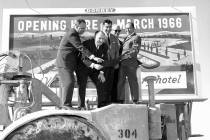Law makes it uncivil, not criminal, to misuse campaign funds
To prevent the Morse Arberry Jr. debacle from happening again, Attorney General Catherine Cortez Masto will ask the 2013 Legislature to make it a crime to spend campaign contributions for personal use.
“We’re going to put back in what they took out in 1997,” Masto said, referring to the criminal penalty exorcised from Senate Bill 215.
The law states: “It is unlawful for a candidate to spend money received as a campaign contribution for his personal use.”
That’s exactly what the former Democratic Ways and Means chairman did. He took $121,000 given to him for his 2008 campaign and put it in his personal bank account.
Why isn’t that already a crime? In 1997, as part of a major election reform bill promoted by then-Secretary of State Dean Heller and then-Gov. Bob Miller, most of the campaign finance reporting violations were made subject to civil rather than criminal penalties.
The bill’s first version made personal use a gross misdemeanor, but legislators didn’t want to make things too tough for themselves, so the version that passed made personal use a civil penalty.
Masto wants to make personal use of campaign funds a class E felony, subject to between one and four years in prison.
She admitted when her office charged Arberry with six fraud and perjury felonies, they hadn’t researched SB215, which decriminalized most campaign reporting violations.
If Arberry had gone to trial, his attorneys, George Kelesis and Mark Bailus, were well-positioned to win the case and humiliate the attorney general’s office. Instead, under a plea bargain, Arberry is on probation for six months, fined $1,000, ordered to pay restitution and banned from running for office again.
Asked whether she was embarrassed by pleading six felonies down to one misdemeanor of fraudulent appropriation of property, Cortez answered, “It’s not embarrassing at all. We can only move forward with the tools that are given us.”
Secretary of State Ross Miller said he would support Masto’s effort to strengthen the law, which 14 years ago was heralded as the first successful reform of Nevada election laws in 20 years.
Its biggest accomplishment was lowering the reporting threshold from $500 to $100 so that the identity of more contributors would be public.
Outrage over Arberry’s plea bargain is likely to spur legislators to approve Masto’s bill. But a dash down memory lane will point out potential problems when “personal use” isn’t defined and interpretations are inconsistent.
Uniformed cop Richard Perkins used campaign dollars to buy suits when he was elected in 1992 to the Assembly. That was deemed OK.
Yet in 2002, an attorney general’s opinion said the law is “generally intended to disallow expenditures of campaign monies for typical personal and household expenses such as food, clothing, rent, utilities and the like.”
Then in 2010, Ross Miller ruled it was OK for Las Vegas Assemblywoman Kathy McClain to use campaign funds to pay rent in Carson City during the session. But she shouldn’t have used campaign funds to cover contributions to the Public Employees Retirement System.
At one time it was legal to convert campaign surpluses to personal use at the end of a political career — until I wrote about the late Sheriff John Moran’s $192,000 surplus in 1990. Then the law was changed specifying how excess campaign contributions could be used — and it didn’t include personal use.
Arberry, the likable but thieving public official, will prompt another campaign reform and more confusion over what constitutes personal use. He is also a sterling example of why naming buildings after living lawmakers isn’t always smart.
The Morse Arberry Jr. Telecommunications Building at the College of Southern Nevada is now a paean to another corrupt politician, while the wing named after him at the Boyd School of Law at UNLV is an ironic joke.
Too bad it’s not funny.
Jane Ann Morrison’s column appears Monday, Thursday and Saturday. Email her at Jane@reviewjournal.com or call 702-383-0275. She also blogs at lvrj.com/blogs/morrison.












